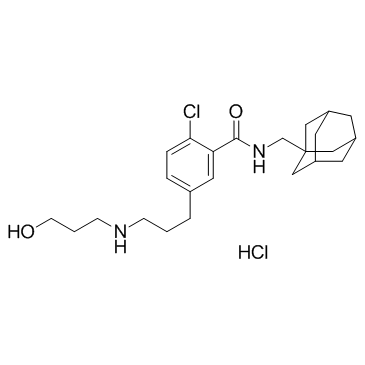AZD9056 hydrochloride
Modify Date: 2024-01-02 09:28:11

AZD9056 hydrochloride structure
|
Common Name | AZD9056 hydrochloride | ||
|---|---|---|---|---|
| CAS Number | 345303-91-5 | Molecular Weight | 455.46100 | |
| Density | N/A | Boiling Point | N/A | |
| Molecular Formula | C24H36Cl2N2O2 | Melting Point | N/A | |
| MSDS | N/A | Flash Point | N/A | |
Use of AZD9056 hydrochlorideAZD9056 is a selective orally active inhibitor of P2X7 which plays a significant role in inflammation and pain-causing diseases. |
| Name | AZD9056 hydrochloride |
|---|---|
| Synonym | More Synonyms |
| Description | AZD9056 is a selective orally active inhibitor of P2X7 which plays a significant role in inflammation and pain-causing diseases. |
|---|---|
| Related Catalog | |
| In Vitro | The antagonist AZD9056 blocks P2X7 receptors with an IC50 of 11.2 nM in HEK-hP2X7 cell line, indicating a high selectivity of the antagonist for the P2X7 receptor. The P2X7-receptor antagonist AZD9056 has a clear inhibitory effect (IC50=1-3 μM) in mouse microglia BV2 cells[1]. AZD9056 is an inhibitor of BCRP and weakly inhibits BCRP-mediated transport of methotrexate (IC50=92 μM)[2]. |
| In Vivo | Treatment with AZD9056 exerts pain-relieving and anti-inflammatory effects. The upregulated expression of interleukin (IL)-1β, IL-6, tumor necrosis factor-α (TNF-α), matrix metalloproteinase-13 (MMP-13), substance P (SP) and prostaglandin E2 (PGE2) which is induced by MIA in cartilage tissues is reversed by AZD9056[3]. |
| Cell Assay | AZD9056 is used as a stock solution in DMSO. Final DMSO concentrations in experiments does not exceed 1.0% (v/v). The effect of agonists on cell viability is assessed in parental HEK293 cells and HEK–hP2X7 cells using the CellTiter-Blue assay. For inhibition experiments, AZD9056 is added to the cells at concentrations up to 10 μmol/L 5 min prior to the addition of ATP (2.5 mM) or BzATP (0.25 mM). After incubation for 30 min at 37°C, an aliquot (20 μL) of the prewarmed CellTiter-Blue reagent is added. Samples are incubated for 1 h at 37°C. Fluorescence signals are measured[1]. |
| Animal Admin | Rats: To reveal the molecular mechanisms of action of P2X7R in articular cartilage in OA-induced pain and inflammation, the antagonist of P2X7R AZD9056 is used. Wistar rats are administered (by intra-articular injection) monosodium iodoacetate (MIA), and the rats with OA are then treated with the P2X7R antagonist, AZD9056[3]. |
| References |
| Molecular Formula | C24H36Cl2N2O2 |
|---|---|
| Molecular Weight | 455.46100 |
| Exact Mass | 454.21500 |
| PSA | 61.36000 |
| LogP | 5.77460 |
| Storage condition | 2-8℃ |
| 2-chloro-5-[3-[(3-hydroxypropyl)amino]propyl]-N-(tricyclo[3.3.1.13,7]dec-1-ylmethyl)-benzamide hydrochloride |
| AZD9056 (hydrochloride) |